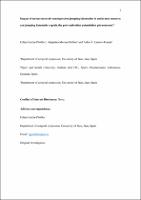Por favor, use este identificador para citar o enlazar este ítem:
https://repositorio.usj.es/handle/123456789/1119
Registro completo de metadatos
| Campo DC | Valor | Lengua/Idioma |
|---|---|---|
| dc.contributor.author | García-Pinillos, Felipe | - |
| dc.contributor.author | Molina-Molina, Alejandro | - |
| dc.contributor.author | Latorre-Román, Pedro Á. | - |
| dc.date.accessioned | 2024-02-12T15:53:55Z | - |
| dc.date.available | 2024-02-12T15:53:55Z | - |
| dc.date.issued | 2015-11-10 | - |
| dc.identifier.citation | Felipe García-Pinillos, Alejandro Molina-Molina & Pedro Á. Latorre- Román (2016): Impact of an incremental running test on jumping kinematics in endurance runners: can jumping kinematic explain the post-activation potentiation phenomenon?, Sports Biomechanics | en_US |
| dc.identifier.issn | 1752-6116 | en_US |
| dc.identifier.uri | https://repositorio.usj.es/handle/123456789/1119 | - |
| dc.description.abstract | This study aimed to determine whether kinematic data during countermovement jump (CMJ) might explain post-activation potentiation (PAP) phenomenon after an exhausting running test. Thirty-three trained endurance runners performed the Léger Test; an incremental test which consists of continuous running between two lines 20 m apart. CMJ performance was determined before (pre-test) and immediately after the protocol (post-test). Sagittal plane, video of CMJs was recorded and kinematic data were obtained throughout 2-Dimensional analysis. In addition to the duration of eccentric and concentric phases of CMJ, hip, knee and ankle angles were measured at four key points during CMJ: the lowest position of the squat, takeoff, landing, and at the lowest position after landing. Additionally, heart rate was monitored, and rate of perceived exertion was recorded at post-test. Analysis of variance revealed a significant improvement in CMJ (p = 0.002) at post-test. Cluster analysis grouped according to whether PAP was experienced (responders group: RG, n = 25) or not (non-responders group: NRG, n = 8) relative to CMJ change from rest to post-test. RG significantly improved (p < 0.001) the performance in CMJ, whereas NRG remained unchanged. Kinematic data did not show significant differences between RG and NRG. Thus, the data suggest that jumping kinematic does not provide the necessary information to explain PAP phenomenon after intensive running exercises in endurance athletes. | en_US |
| dc.format.extent | 14 p. | en_US |
| dc.format.mimetype | application/pdf | en_US |
| dc.language.iso | eng | en_US |
| dc.publisher | Taylor & Francis Group | en_US |
| dc.relation | This study received no financial support. However, the authors would like to thank 'Club Atletismo Unicaja (Jaen)', 'Club Atletismo Renacimiento (Ubeda)' and 'Club Atletismo Media Legua (Baena)' for their support and collaboration, and also all those athletes who contributed in this research. | en_US |
| dc.rights | Attribution-NonCommercial-NoDerivatives 4.0 Internacional | * |
| dc.rights | Attribution-NonCommercial-NoDerivatives 4.0 Internacional | * |
| dc.rights | Attribution-NonCommercial-NoDerivatives 4.0 Internacional | * |
| dc.rights.uri | http://creativecommons.org/licenses/by-nc-nd/4.0/ | * |
| dc.subject | Countermovement jump | en_US |
| dc.subject | Graded exercise test | en_US |
| dc.subject | Long-distance runners | en_US |
| dc.subject | Neuromuscular response | en_US |
| dc.subject | Two dimensional analysis | en_US |
| dc.title | Impact of an incremental running test on jumping kinematics in endurance runners: can jumping kinematic explain the post-activation potentiation phenomenon? | en_US |
| dc.type | info:eu-repo/semantics/acceptedVersion | en_US |
| dc.identifier.doi | http://dx.doi.org/10.1080/14763141.2016.1158860 | en_US |
| dc.rights.accessrights | info:eu-repo/semantics/openAccess | en_US |
| Aparece en las colecciones: | Artículos de revistas | |
Ficheros en este ítem:
| Fichero | Descripción | Tamaño | Formato | |
|---|---|---|---|---|
| Impact of an incremental running.pdf | 234,5 kB | Adobe PDF |  Visualizar/Abrir |
Este ítem está sujeto a una licencia Creative Commons Licencia Creative Commons

